|
Choosing lenses for the D30
The most asked question concerning the D30 is
“what lenses do I buy?” It’s
a bit like asking a stranger what clothes you should be wearing. Everyone’s needs will
differ, and lens choice is indeed as personal as your clothes.
But just like fashion folk can make
recommendations as to what will be the appropriate dress for certain
occasions, there is some fairly standard lens buying advice that can
be given. With that in
mind, we offer the following:
The 1.6 Factor
There are a lot of places on the net where you
can find people who will tell you what lenses they are using and
what they like. For a
first timer shopping for his lens set (or someone looking to add a
lens to their collection) these sites are very useful. So far, at least, there are
no D30 specific lens sites.
Places rating the various Canon lenses
available are nearly all from the standpoint of the Canon film
cameras. While there are certain characteristics common to the film
cameras and the D30, there is also one big factor that’s very
different – the 1.6 multiplication factor.
We won’t get into the debate about what this really
means, but for all intents and purposes the effect of the 1.6 factor
is that every lens you purchase will have its focal length
multiplied by 1.6 when used on the D30. This results in two very
important effects:
1)
Your lenses become longer (duh). A 200mm lens effectively becomes a 320mm lens. Truly very wonderful if you
like longer lenses. However,
that 17mm lens now becomes a 28mm lens, which isn’t so great if
wide angle is your thing.
2)
Because you are using only the center 80% or so of a lens,
the problems that often occur with lenses related to edge effects
(such as distortion) become far less significant. This is particularly
important when you consider reviews of lenses that typically take
these edge problems into account when doing the ratings.
Because of these two effects the information
you read about Canon lenses needs to be taken with a grain of salt. If someone tells you the all-time most used lens he owns is a
50mm lens and you think to yourself “hey, I should be using that
focal length because my shooting is very similar to his” you have
to stop and remember that a 50mm lens won’t be a 50mm lens
on your D30 – in order to get that length you’ll need to use a
32mm lens (or the closest equivalent). If someone tells you that a
certain lens isn’t very good because of the barrel distortion at
the edges, you need to remember that if that’s the only problem
with the lens, it won’t be a problem on the D30.
With that in mind, there are several useful
sites that rate lenses both from an objective standpoint (using
measurable tests) as well as a personal preference standpoint (based
on user feedback). Here
are the three we like:
http://www.photozone.de/lsurveyEOS.htm
User experiences about Canon lenses.
http://www.photographyreview.com/reviews/35mm_zoom_lenses/
More user experiences on lenses (and other
photo equipment).
http://www.photodo.com/nav/prodindex.html
Objective lens performance tests
Cropability (or why you want to use zooms almost
exclusively on your D30)
Okay, it’s probably not a word, but it does
sum up another major difference between the D30 and the film world. In the film world (even in the world of the small format
35mm) unless you’re shooting slides exclusively you have a lot of
latitude when it comes to composing your image. You can crop into your image
and effectively increase your zoom, and recompose your image by
shifting things right, left, up or down.
If you are going to be printing from your D30
images your ability to crop becomes a lot more limited. Producing a 4x6 print gives
you some room, but if you are going for a Super B print (13x19
inches) or even an 8x10 you really don’t want to lose any of those
precious pixels (see this discussion).
Because you want to get as close as possible to
your final composition, the issue of using zoom lenses versus fixed
becomes very clear – in general, you’ll want the zoom nearly
every time.
The zoom will give you the ability to compose just
right and today’s modern zooms suffer from nearly none of the
problems zooms in the past did.
With the exception of macro and very low light lenses, zooms
on the D30 are really the only way to go.
Lens choice and usage
Wide Angle:
Wide angle lenses are the most difficult lenses to use of
all. Because the number
one factor in good photographs is a clear subject, a wide angle
tends to subvert the essence of a great image. Things that are not part of
the subject start to creep in right away, and soon you’re left
with a big mess, a kind of snapshot that most amateurs make with
their point & shoot cameras.
The best use of wide angles come in interiors,
where you can’t get back far enough, and environmental portraits,
where you’d like to place the subject within the environment. Landscapes are a type of
environmental “portrait”, but it’s easy to get carried away
there. If you are
shooting an image of the Devil’s Tower, you really don’t need to
see miles and miles of the scenery surrounding it.
Some of the best wide angle scenery shots
include very close foreground images, such as flowers, that frame a
much larger background subject.
Takes a whole lot of work to get good at using a wide-angle
lens (probably why I don’t use mine often).
Medium Range: The medium range lenses are where
you’ll do the bulk of your work.
For years great photographs have been made with the fixed
50mm lens on many a rangefinder 35mm.
Good head and shoulder portraits (the “traditional”
portrait shot) are usually made with lenses in the 80-120mm range. It’s said that our eyes
have an angle of view that corresponds to the 100mm lens, which is
why a lot of images taken there seem so natural.
Telephoto: A good telephoto is a must if you do
any sports or nature photography.
You cannot get close enough to the animal, whether that
animal is a midget owl or a linebacker playing for the St. Louis
Rams.
A long lens will also let you pick out details
in the landscape, often isolating patterns that cannot be seen with
any other lens.
Macro: A macro allows you to get extremely
close to your subject, which is often so small that details the
naked eye will not reveal can be seen. Like the wide-angle, it’s
a difficult lens to use, and for similar reasons. You must be able to identify your subject, and with a macro
lens that often means hunting around with the lens itself until you
can see it yourself.
The natural world is almost the exclusive
subject of macro photography, although man-made objects up close can
be interesting at times.
What about the new DO lenses?
Anyone who follows camera news knows about the
upcoming DO lenses from Canon.
You can read about the technology here.
So far, the only lens announced is that 400mm
prototype (and it didn’t make it in this first half of this year
as promised). Should
you wait for a new crop of lenses to make their appearance?
It’s anyone’s guess, but it’s pretty safe
to say these will be expensive lenses. Whether Canon will be
able to keep the same excellent quality without increasing weight
and size at a same aperture zoom is something we may not know for
years. It’s basically
like everything else in life: you can wait and see if things come
out that are better, or you can take a chance and have fun now. I vote for having fun now,
but those of you who are young enough to spare a few years might
very well want to wait around (if I were in my early twenties I’d
think I had plenty of time ahead of me).
Lens Variability
There's been a lot of discussion on DPreview lately concerning how
some people's tests are finding some lenses not to be as good as
reviews indicate, while other lenses seem better than are commonly
thought.
It appears there is a lot of variability in the
quality of lenses from all the major manufacturers, which is
disconcerting at best. It also raises in my mind the value of
ratings from web sites (noted above) that take user's own
experiences into account -- the greater the universe sample the
better.
If the same lens can vary so much in quality it
would behoove anyone interested in the best to get some kind of
return policy on every lens they buy. Most major stores and
online sellers will offer this (B&H, for example, offers
a 14 day free exchange or return policy). If you buy a lens that is
highly rated and doesn't perform well for you, the odds are that
you've gotten a "bad" one, and should try again. As
a general rule there's a very good reason the top rated lenses are
so rated.
Our Lens Collection
Here’s what we own and our impressions (and a
tip of the hat to www.luminous-landscape.com,
which does a very similar roundup of lenses, albeit from a film
camera standpoint. The
site does contain a lot of D30 information, and the owner/operator
now operates almost exclusively with a D30, but his lens roundup was
written prior to his D30 use).
All lenses are pictured actually mounted on
the D30, which will give you a much better idea exactly how big each
of them is. They are shown with and without a lens hood --
most pros will seldom shoot without a lens hood for good reason, and
you shouldn't either. Weights
are noted next to the lens description. I’ve omitted Photodo
ratings, although you can look them up if you like. As noted earlier, these
ratings were not done with the D30 in mind, and have to be taken
with a large dose of salt.
I’ve also included the approximate street
price of each lens, effective 7/9/01.
While discounts vary widely, this will at least give you an
idea of the ballpark price of some of these fairly pricey items.
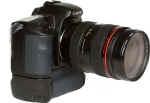 
Canon 28-70mm f/2.8 L
Weight: 30.8 oz
Street Price: $1100
Without a doubt the best and most frequently
used lens in our collection. It’s
heavy as sin and looks so imposing no one will mistake you for a
casual shooter, but the images it produces are crystal sharp and the
D30 effective range is 45-112mm, which is perfect for portraits,
landscapes and just about every situation you don’t need a very
wide angle or extreme telephoto.
This is my “desert island” lens – the one
lens I’d take with me if I were forced to live with just one. 70% of the images on this
site were taken with it.
 
Canon 70-200mm f/2.8 L
Weight: 2.8 lbs
Street Price: $1200
Considered by many as the best zoom Canon
makes, the 70-200mm lens is the kind of lens that will draw
attention from almost any situation you are in (not always a good
thing, but one that will definitely make you feel like a shooter). I cannot tell you how many
times people have commented on my camera when this lens is mounted,
or made asides to their friends (“That man is a professional
photographer” I’ve heard explained to others again and again).
The lens is the size of a ’57 Buick and
weighs almost the same, and mounted to the D30 with battery grip you’re
holding something that Arnold uses in his workouts. Indeed, after a day of
carrying it around you’ll be as pumped up as any weight lifter.
But the images this lens produces are nothing
short of remarkable – sharp and clear even wide open at the long
end, this is a truly luscious lens.
With a D30 effective range of 112-320mm it provides you with
a long view that 35mm film users lust after. It’s even more remarkable
mounted with the 1.4x or 2x teleconvertors (see below).
This is my second favorite lens and about 25%
of the images on this site were taken with it.
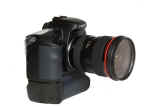 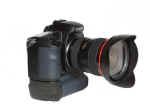
Canon 17-35mm f/2.8 L
Weight: 19.1 oz
Street Price: $1250
The last lens of the Canon f/2.8 L zoom “set”,
this lens is a favorite of nature photogs and anyone who wants a
truly wide angle lens.
Unfortunately, in the D30 world this becomes a
27-56mm lens. Wide
angle, yes, but nothing approaching the truly spectacular wide angle
look it has with film cameras.
With wide angle lenses, every little millimeter is important,
and the inability to get much wider than a “standard” 28mm lens
is a big disappointment to many.
The good news is that this lens on the D30
exhibits none of the problems many shooters have reported with it on
film cameras. Wide
angle lenses usually have most of their difficulties with the edges,
but on the D30 this isn’t even a concern. I’d rate the quality of
images it produces nearly on par with both of my other f/2.8 L
lenses.
I’m not much of a wide angle user, however. This lens gets used the
least of all my lenses, and is one I often leave behind on a shoot
without missing it. I
used it extensively when I shoot interiors of the Governor’s mansion, but mostly it’s a
niche lens in my collection.
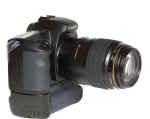 
Canon 100mm f/2.8 Macro
Weight: 21.1 oz
Street Price: $600
If you need one macro lens in your collection
you must consider this terrific lens. At an effective 160mm on the
D30, this one will allow you to get very close to your subject without
getting close, if you catch my drift.
It works very well with the MR-14 ringlite.
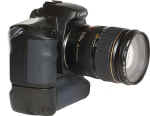 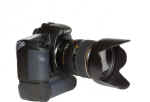
Canon 28-135 f/3.5-5.6 IS
Weight 17.6 oz
Street Price: $470
This is the lens many people consider when
equipping their D30. It
has much to recommend it – a wide range (45-216mm effective),
image stabilization (which allows the handholding of the camera at
much slower speeds than normal) and a lens quality which approaches
the pro standards. It
has been said this is the finest “non-L” lens that Canon makes. And it’s price certainly
makes it attractive to those who cannot afford the better glass.
I have it mounted full-time on my backup D30
body, and often carry it with me just to have a camera (“Always
carry a camera”). While
not exactly small and light, it certainly is much more compact than
all but the 17-35mm zoom. The
images it produces look very good indeed, nearly on a par with my
pro glass. It also can
double as a “macro” lens, since its close focusing abilities at
the extreme zoom range make it possible to get to 1:2 on the D30.
I dislike variable aperture intensely, however. IS doesn’t really make up
for the lack of f/2.8, particularly at higher zoom lengths. This is not the
lens I’ll ever use if I have to shoot in low light. And, truthfully, it’s not
the lens I’ll use on any critical shoots. Can I see the difference
between it and my L glass? You
betcha. After having
paid a lot of money for the D30 it just doesn’t seem sensible to
scrimp on lenses. For just knocking around and shooting candids,
however, nothing can beat it.

Canon 50mm f/1.8
Weight: 4.6 oz
Street Price: $85
Everyone has at least one low light lens in
their collection, and it’s usually either this feather light lens
or the much heavier (and much more expensive) 50mm f/1.4.
You’ll gain nearly another stop with the
f/1.4, but if you don’t do a lot of low light shooting it may be
hard to justify its $350 street price. Buying this lens, on the
other hand, is almost a no-brainer.
With the 80mm effective length on the D30, it
may double as a portrait lens.
I don’t do a lot of low light stuff, so this lens doesn’t
get used much, but when you need it, nothing else (with the
exception of that f/1.4) will do.

1.4x and 2.x Canon Teleconverters
I use these exclusively with my 70-200mm 2.8
lens. The 1.4 turns
that lens into a 157-448mm f4, and the 2x turns it into a 224-640mm
f5.6 monster of a lens.
They don’t add much weight to the lens, but
the 70-200mm is already a beast to carry and these little
attachments seem to make a big difference, both in length as well as
heft. I can definitely
tell when I have one of them on the big gun (and so can others –
mount the 2x on your 70-200mm and you won’t be shooting any
candids).
On the D30 the image quality remains very, very
good – I wouldn’t hesitate at all using them under nearly any
conditions. There are,
however, two drawbacks. First,
you lose one stop with the 1.4x, and two stops with the 2x. That can be a problem,
particularly since you need to shoot faster to get sharp enough
images at these lengths. Outside,
during the day, I wouldn’t worry at all. Low light conditions are
going to be problematic.
The second problem is that of focus – auto
focus has a hard time dealing with the 2x in particular. This isn’t a terrific
problem, since at these lengths you’ll probably want to manually
focus most of the time anyway, but it worries a lot of people. Given that you can carry a
640mm f5.6 pro quality lens around for a fraction of the cost of the
600mm f4 (current street price around $8700) it makes a lot of sense
to me.
(Then again, to be fair, you wouldn’t
actually need to buy that 600mm lens to get the same focal length. Canon makes a 400mm f/5.6
lens, for around $1300, which would give you that 640mm range. But it weights 3 lbs and is
about the same size as the 70-200, so you’d effectively have to
carry both of them to get close to the same capabilities. That doesn’t make a lot of sense to me).
Both converters run less than $400 each.
|